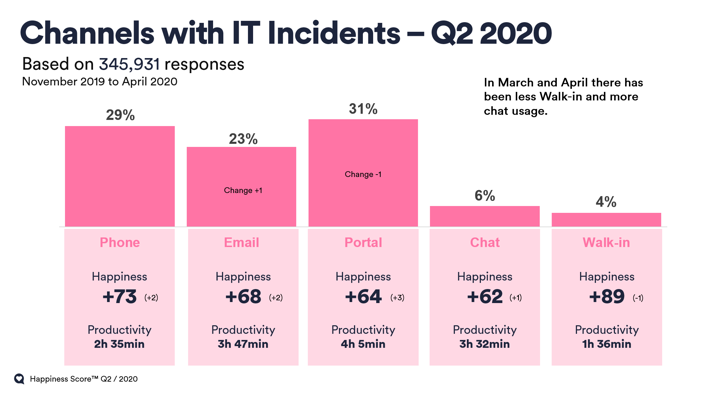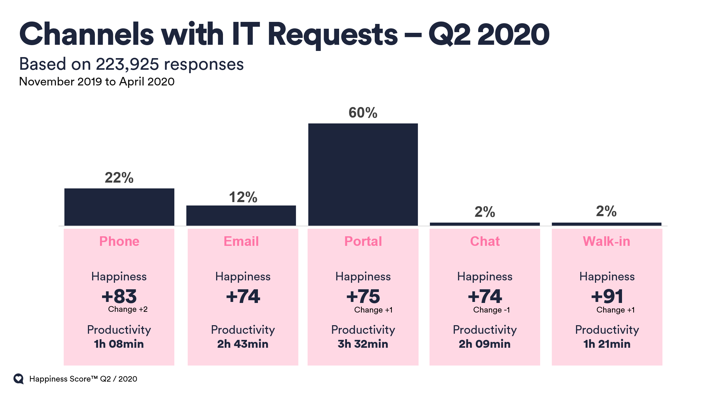
What the New Normal Means for Your IT Self-Service Portal
The COVID-19 crisis changed the world forever. It changed society. It changed businesses. And it also changed IT support. The need to support a massive increase in home workers, in particular, meant that not only were remote support tools the order of the day, hopes were also pinned on IT self-service capabilities for both incident and service request management. To provide swifter employee service and support while also relieving some of the pressure on overworked IT service desks.
Of course, IT self-service wasn’t the only IT service management (ITSM) capability available to help. But it’s the one that was – and still is – a natural fit for better enabling remote workers. After all, who wouldn’t want an IT support capability that, in theory, empowers employees to help themselves through faster resolutions?
So, what went wrong with IT self-service?
IT self-service must work better in the new normal says @Joe_the_IT_Guy. Here he explains. #servicedesk Share on XIT self-service must work better in the new normal
Or, to be more precise, IT self-service must work better for employees. Because this is the only way that it’ll work better for IT departments in terms of realizing the available supply-side benefits. The industry already knows two key common barriers to self-service adoption:
- Failing to design self-service capabilities around employee wants and needs, including their ways of working
- Insufficient marketing of the self-service capability – from what’s possible to how everyone benefits from its use.
But let’s dig deeper into its current operation.
Current self-service adoption levels and the associated employee experience
The latest HappySignals employee experience data shows that, for incident management, self-service is still significantly behind the telephone channel in terms of employee happiness (at +64 versus +73). It also slightly dropped in channel share rather than going up during the crisis. With the lost productivity level of over four hours a contributor to both of these metrics.

The service request view of the self-service IT support channel is both similar and different. The good news is that self-service is now by far the predominant support channel for service requests at 60%. However, while the happiness score is much better for requests than incidents, there are still issues with the level of employee lost productivity. With self-service oddly still causing an extra 45 minutes of lost productivity even against the email channel.

Addressing the issues with IT self-service
The new IT support normal for businesses and their employees is not only about remote workers and their enablement. It’s also going to be difficult financially as both business and consumer customers struggle to return to as close to normal, in terms of their spending, as they can post-crisis. The opportunity for IT self-service is, therefore, also one related to the available people resources and budgetary restrictions.
The latest @HappySignalsLtd employee experience data shows that, for incident management, #selfservice is still significantly behind the telephone channel in terms of employee happiness (at +64 versus +73). Share on XSo, what does the HappySignals data tell us?
Self-service is always going to achieve a higher adoption rate for service requests than it is incidents. The immediacy of need is going to dictate this. But surely there should be fewer emails reporting incidents and greater uptake of self-service (as well as for requests still)?
Looking at the data, there are two key data points to consider – employee happiness and lost productivity, with the former strongly influenced by the latter (in terms of speed of resolution or provisioning). The big question then is: “Why does it take so long to get IT support for both incidents and requests via self-service?” For which there are many potential answers.
Comparing self-service to the email channel
On the face of it, the comparison of self-service to email should show a similar set of datapoints because much of the process is the same. The only real difference is the time it takes to write an email versus the time it takes to find the self-service portal and complete a form. This might account for much of the 18-minute difference for incidents but surely not for the 49-minute difference for requests.
Here it suggests that emailed requests are given priority over self-service requests or that end users provide more details via email than is requested via self-service (negating the need for analysts to request more information from them). Unless, playing devil’s advocate, the self-service requests are consistently a lower priority, using formal prioritization techniques, or more difficult to handle than those emailed in.
Here, in addition to fixing any self-service form issues, there’s the opportunity to give “like-for-like priority” to requests submitted via self-service to help improve its uptake.
Comparing self-service to the telephone channel
For incidents, 90 additional minutes of productivity are lost via self-service. And, even more worryingly, 144 minutes for requests. Some of this will probably relate to first-time fix targets – that a telephone call will most likely be met by an analyst keen to resolve the issue or request immediately no matter the priority level.
According to @HappySignalsLtd data, 90 additional minutes of productivity are lost via #selfservice for incidents. And, even more worryingly, 144 minutes for requests. But WHY?! #servicedesk Share on XHowever, the significant variance in the level of lost productivity again needs explaining further. Especially when the end user might incur a queue-based delay via the telephone channel.
The three most-likely possible reasons, in addition to the relative priority given to self-service incidents and requests, are:
- Lack of suitable knowledge articles for self-help – which could relate to their absence, ease of understanding and use, or the ease of finding them.
- Workflow issues – that self-service approvals and actions incur some form of bottleneck. Although this would likely be true for the telephone channel too (unless it’s a priority-based issue again).
- Lack of automation and service orchestration for self-service-based incident resolution and service provisioning (which could also apply to a lesser extent with analyst handled tickets). This not only removes the immediacy that employees are seeking (through self-service), it adds delays and costs while employees wait for a service desk analyst to pick up and action their tickets.
How to improve IT self-service to better support the new normal
There might, of course, be other causes of low self-service adoption levels in your organization that are in part fueled by the poor employee experience (even if only perceived). However, the following five actions will help your organization to finally succeed with its self-service capabilities to better support all, not just remote, employees in the new normal:
Here @Joe_the_IT_Guy offers up 5 ways to improve IT self-service to better support the 'new normal.' #servicedesk Share on X- Sense check your current self-service capabilities versus what employees want, need, and expect. Especially versus the consumer-world services they use. Make the changes required to better align supply to demand.
- Create and run a formal marketing campaign that explains the why, the how, and the “What’s in it for me?” of self-service to employees. Provide light training, on the self-service capabilities, to employees that want/need it.
- Understand whether self-service-created tickets are receiving second-class treatment. Use “like-for-like prioritization” of self-service tickets (if necessary) to up its performance and the channel’s attractiveness to employees.
- Review the use of your self-help knowledge management capabilities. Identify and fix any significant gaps and use issues.
- Introduce automation and service orchestration capabilities to improve the speed of self-service resolution and service provisioning. Without such automation, people might as well continue to call or email the service desk because it’s quicker.
If your organization has succeeded with IT self-service, what would you add to this list? Please let me know in the comments.






